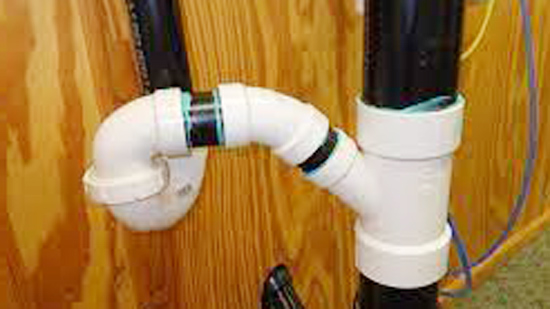Can you mix ABS and PVC pipes?
When it comes to plumbing projects, understanding the compatibility of different pipe materials is essential. One common question that arises is whether it’s possible to mix ABS and PVC pipes. In this article, we will dive into the topic and provide you with the facts you need to know.
ABS (Acrylonitrile Butadiene Styrene) and PVC (Polyvinyl Chloride) are both types of plastic pipes commonly used in plumbing systems. They have distinct characteristics that can impact their compatibility. Mixing ABS and PVC pipes without proper considerations can lead to structural issues and leaks.

Photo by familyhandyman
In this guide, we will explain the differences between ABS and PVC pipes, discuss their respective strengths and weaknesses, and explore the various scenarios where you may need to combine them. We will also provide expert insights and recommendations on how to ensure a safe and efficient plumbing system.
ABS and PVC pipes
To understand the compatibility of ABS and PVC pipes, it’s important to first grasp their individual characteristics. ABS pipes are known for their durability, impact resistance, and excellent temperature resistance. They are commonly used in residential plumbing systems for waste and vent pipes.
On the other hand, PVC pipes are lightweight, corrosion-resistant, and have a smooth inner surface that allows for efficient water flow. PVC pipes are commonly used for water supply lines and underground drainage systems.
Properties and differences between ABS and PVC pipes
While both ABS and PVC pipes are made of plastic, they have significant differences that affect their compatibility. ABS pipes are black in color and have a matte finish, while PVC pipes are white or cream-colored and have a glossy appearance.
ABS pipes are generally stronger and more flexible than PVC pipes, but they are more susceptible to damage from sunlight exposure. PVC pipes, on the other hand, are more rigid and have higher tensile strength.
Another key difference between ABS and PVC pipes is their temperature resistance. ABS pipes can withstand higher temperatures, making them suitable for hot water applications, while PVC pipes have a lower temperature resistance and are recommended for cold water systems. It’s crucial to consider these differences when determining whether to mix ABS and PVC pipes.
Can ABS and PVC pipes be mixed?
The short answer to this question is no, ABS and PVC pipes should not be mixed. Mixing these two materials can lead to compatibility issues, which can result in leaks, structural problems, and even health hazards. The primary reason for not mixing ABS and PVC pipes is their different solvent cements.
ABS pipes require ABS-specific cement, while PVC pipes require PVC-specific cement. Attempting to join ABS and PVC pipes with the wrong cement can weaken the joint and cause leaks.
ABS and PVC pipes have different expansion and contraction rates when exposed to temperature changes. This can further compromise the integrity of the joint, leading to potential leaks and system failure.
It’s important to adhere to manufacturer guidelines and use the appropriate materials for each type of pipe to ensure a safe and reliable plumbing system.
Risks and issues of mixing ABS and PVC pipes
Mixing ABS and PVC pipes can pose several risks and issues that can have serious consequences for your plumbing system. One of the main concerns is the potential for leaks. The incompatible solvents used to join ABS and PVC pipes can weaken the joint, resulting in water leakage. This can lead to water damage, mold growth, and costly repairs.
Another issue is the difference in expansion and contraction rates between ABS and PVC pipes. When exposed to temperature changes, ABS and PVC pipes expand and contract at different rates. This can put stress on the joint and cause it to fail over time. In extreme cases, this can result in burst pipes and significant water damage.
Furthermore, mixing ABS and PVC pipes can also have health implications. ABS pipes are known to release harmful chemicals when exposed to high temperatures, such as when used for hot water applications.
These chemicals can contaminate the water supply and pose a risk to human health. It’s crucial to prioritize safety and follow industry best practices when it comes to plumbing materials.
Safety considerations when working with ABS and PVC pipes
When working with ABS and PVC pipes, there are important safety considerations to keep in mind. First and foremost, it’s essential to wear appropriate personal protective equipment, such as gloves and safety glasses, to protect yourself from any potential hazards. Additionally, ensure proper ventilation in the work area to minimize exposure to fumes and chemicals.
It’s also crucial to follow manufacturer guidelines and use the correct solvent cement for each type of pipe. Using the wrong cement can compromise the joint, leading to leaks and system failure. Take the time to read and understand the instructions provided by the pipe manufacturer and follow them diligently.
If you encounter a situation where you need to connect ABS and PVC pipes, it’s recommended to consult with a professional plumber who has experience in handling such scenarios. They can provide expert advice and guidance to ensure a safe and reliable connection.
How to properly join ABS and PVC pipes
While mixing ABS and PVC pipes is not recommended, there are instances where you may need to connect them. In such cases, it’s crucial to follow the proper procedures to ensure a secure and leak-free joint. Here are the steps to properly join ABS and PVC pipes:
Cut the pipes: Use a pipe cutter or a hacksaw to cut the ABS and PVC pipes to the desired length. Ensure the cuts are clean and square for a proper fit.
Deburr the edges: Use a deburring tool or sandpaper to remove any rough edges or burrs from the cut ends of the pipes. This will help ensure a smooth and tight fit.
Clean the pipes: Thoroughly clean the cut ends of the ABS and PVC pipes using a suitable cleaner. Follow the manufacturer’s instructions to ensure proper cleaning.
Apply solvent cement: Apply the appropriate solvent cement to the outside of the ABS pipe and the inside of the PVC pipe. Use a brush or applicator to evenly coat the surfaces.
Connect the pipes: Insert the ABS pipe into the PVC pipe, twisting slightly to ensure an even distribution of the cement. Hold the pipes together firmly for a few seconds to allow the cement to bond.
Allow curing time: Follow the manufacturer’s instructions for the recommended curing time of the solvent cement. Avoid disturbing the joint during this period to ensure a strong and secure connection.
It’s always best to consult with a professional plumber before attempting to join ABS and PVC pipes. They can provide specific guidance based on your unique situation and ensure a safe and reliable connection.
Alternatives to mixing ABS and PVC pipes
If you find yourself in a situation where you need to connect ABS and PVC pipes, but want to avoid the risks associated with mixing them, there are alternatives available. One option is to use transition fittings specifically designed for connecting ABS and PVC pipes. These fittings provide a secure and leak-free connection, eliminating the need for mixing incompatible materials.
Transition fittings come in various types, such as rubber couplings, compression fittings, and mechanical couplings. Each type has its own advantages and installation requirements, so it’s important to consult with a professional plumber to determine the best option for your specific needs.
Common misconceptions about mixing ABS and PVC pipes
There are several misconceptions surrounding the mixing of ABS and PVC pipes that need to be addressed. One common misconception is that using a universal solvent cement or adhesive can effectively join ABS and PVC pipes. This is not the case. Universal solvents are not specifically formulated for ABS and PVC pipes and can lead to weak joints and leaks.
Another misconception is that using a transition fitting is always necessary when connecting ABS and PVC pipes. While transition fittings are recommended for a secure connection, there are instances where they may not be required. It’s important to consider the specific circumstances and consult with a professional plumber to determine the best approach.
Professional advice on ABS and PVC pipe compatibility
When it comes to the compatibility of ABS and PVC pipes, it’s always best to seek advice from a professional plumber. They have the knowledge and expertise to assess your plumbing system and provide accurate recommendations. Here are some key points to keep in mind when seeking professional advice:
- Consult with a licensed plumber who has experience working with ABS and PVC pipes.
- Provide detailed information about your plumbing system, including the type of pipes currently in use and the specific requirements of your project.
- Ask about any potential alternatives to mixing ABS and PVC pipes that may be suitable for your situation.
- Inquire about any local building codes or regulations that may impact the use of ABS and PVC pipes in your area.
By seeking professional advice, you can ensure that your plumbing system is safe, efficient, and compliant with industry standards.
Conclusion
It is not advisable to mix ABS and PVC pipes in plumbing systems. Despite being made of plastic, ABS and PVC pipes have different characteristics and are not compatible with each other. Mixing these materials can lead to leaks, structural issues, and health hazards.
The properties and differences between ABS and PVC pipes is essential for making informed decisions when it comes to plumbing projects. It’s important to prioritize safety and follow industry best practices to ensure a reliable and efficient plumbing system.
If you find yourself in a situation where you need to connect ABS and PVC pipes, it’s recommended to consult with a professional plumber who has experience handling such scenarios. They can provide expert advice and guidance to ensure a secure and leak-free connection.
When it comes to plumbing projects, it’s always better to be safe than sorry. So, avoid the temptation to mix ABS and PVC pipes and opt for suitable alternatives when needed. By doing so, you can enjoy a trouble-free plumbing system for years to come.


